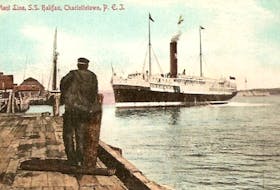SYDNEY MINES, N.S. — Most Wednesday nights in the fall and winter, Earl Cantwell and a group of hardy fishers get together at Sydney Mines Minor Baseball Building on Pitt Street to make some pretty al-luring items.
And "luring’" is the operative word, since the group is making flies for fishing in the ancient, time-honoured craft known as fly-tying. While the real thing probably tastes better to the fish, most flies try to avoid becoming fish food. And since real flies are annoyingly hard to catch, fishers have been improvising with the handmade variety for thousands of years.
Creating fishing lures that resemble the various life cycles of insects has been around since 3000 BC when Chinese fishermen used a bird feather attached to a hook to catch a fish. Apparently the Macedonians used dyed wool for the fly’s body and rooster feathers for the wings. And books on the subject date as far back as 1486 in England. Encyclopedia Britannica estimates there are more than 5,000 books written in English alone written on angling and fly-tying, with the best known being by aristocrat Charles Cotton whose system of knowing what flies were preferred by those hungry fishies was included in part two of later editions of Izaak Walton’s “The Compleat Angler,” in the second half of the 17th century, still one of the best known books on fishing.

But in Sydney Mines on a Wednesday night, the biggest obstacle to the time-honoured craft is actually getting there, thanks to a recent spate of bad weather. Despite the snow and winds, Cantwell says the sessions are a popular option for those who want to learn.
“We have a bunch of tiers, some in their 80s, some in their 70s, some younger than that and we encourage new tiers to come in and give it a try and see if they like it,” says Cantwell. “It’s a fun evening. Starts around 7 and ends around 9.”
Cantwell has fished for years and came to fly-tying as a better way to catch fish.
“With the declining stocks I thought there had to be a better way of fishing where you could return fish without doing a lot of harm to them,” Cantwell explained in a recent interview. “If a fish takes a live bait, it tends to swallow them pretty deeply and lots of time they get hooked in the throat or the back of the tongue so I thought fly-fishing would be a pretty good option and that I would give it a try. I used to buy some flies … but they would fall apart sometimes before they would even hit the water. I’m mostly Scottish so I thought if there’s some way to save some money I would learn to tie my own.”
Ironically, like most hobbies, it’s not hard to get carried away, especially since there are plenty of interesting tools and supplies available. Prices for basic tools like thread winders can range from a few bucks to thousands of dollars.
“I got into it to save money but I’ll never, ever, ever get rid of enough stuff to save enough money for the material I bought,” Cantwell laughs. “It’s just like any hobby. You go into a shop like that you’re like a kid in a candy store. It’s a good thing to leave your credit card at home and just go in with a certain amount of cash so when it’s gone, it’s gone.”
One of the best parts of joining the Sydney Mines club is being able to try out gear before buying anything.
“It can become a rich man’s hobby,” says Cantwell. “We invite people to come in and give it a try and see if you like it before you go out and spend a minimum of $60 or $70 between material and tools and find out that you don’t like it. Most of us have been at it for a long time. It’s a wonderful hobby but it’s not for everybody.”
Smaller hands with lots of dexterity and good eyesight can be helpful when tying flies but for the most part, anyone can do it, says Cantwell. Depending on the type of flies being created, it can take anywhere from five minutes to any number of hours to create one. Some are functional while others look like jewelry. It’s up to its creator and future fisher how to use it.
“Some are elaborate works of art and some are just a functional thing to help catch a fish.”
RELATED:








